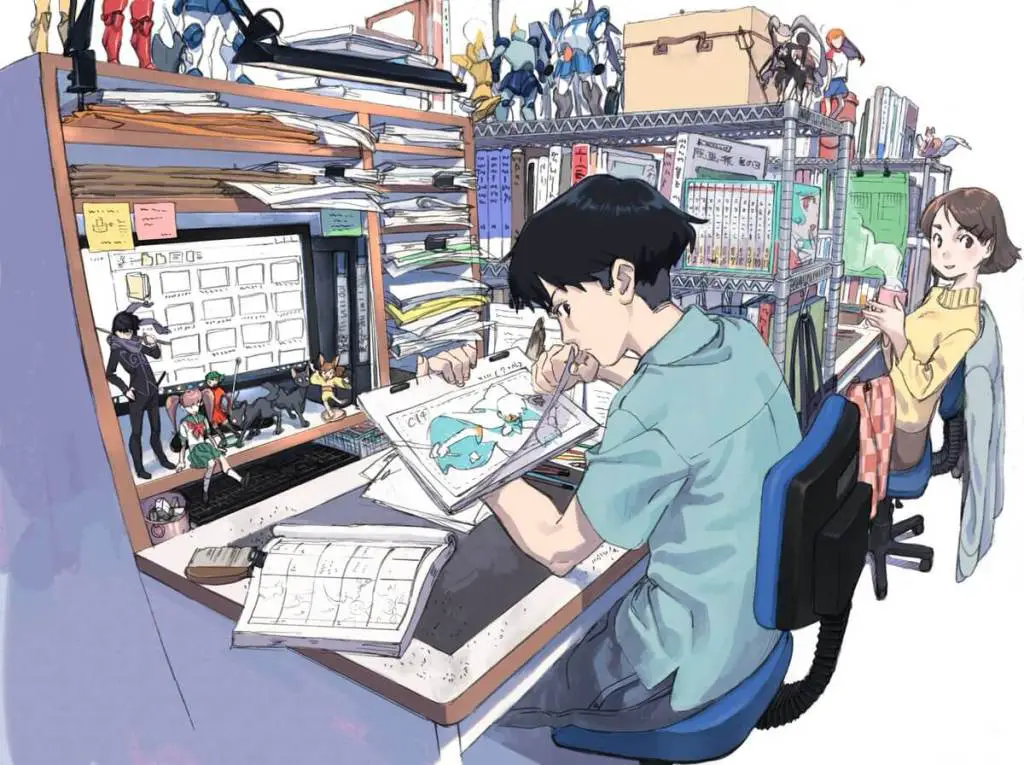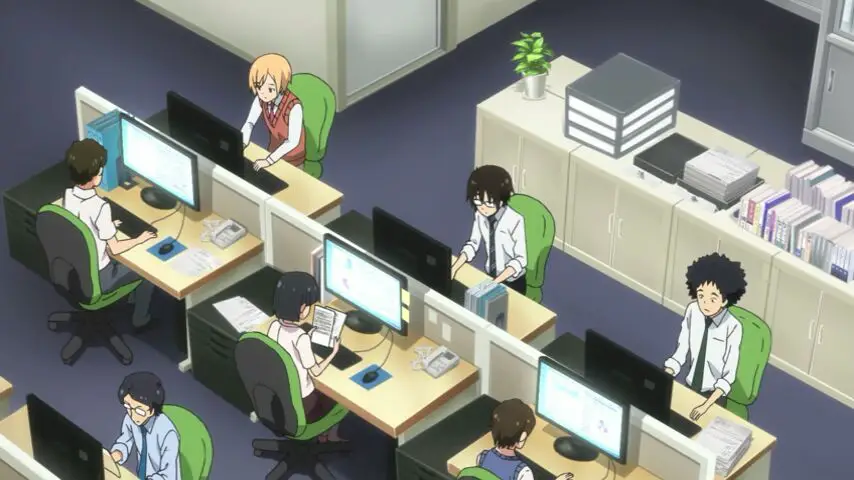Learning about the process of creating anime can be both interesting and insightful. It’s the quintessential tour of the sausage factory. You might have loved anime for any number of reasons. It might have been the cool characters, or the overall story, or the graphics. Whatever it was, you can bet that it’s because someone in the production team did a really good job. The mere fact that different people love animations for different reasons means that the teams behind them are trying hard to make these things masterpieces in all aspects. The sound, the graphics, the story, the characters, even the colors are often crafted with such attention to detail as to rival any other work of art you can imagine.
That it takes talent to make a great anime is no secret, but I’m sure you want to know the details. What is the process of creating anime like, and how long does it take? I was also interested in these details, and so I decided to do some research, then write about it.
¿Cuánto tiempo se tarda en producir un anime?

This is, generally speaking, a function of complexity. The more complex the design of the anime, and the level of detail, the longer it is likely to take. Rome wasn’t built in a day, and a high quality anime isn’t made in one either.
For a simple animation, without any animated characters and very few details, you can expect total production time to be less than a week. More demanding scenes that involve moving characters and intense activity, such as fights, could take weeks, months, or even years. You’re definitely not going to make naruto en un par de semanas!
Como regla general, un anime de 60-90 segundos tardará unas 6 semanas en producirse en promedio. Esto depende del estilo de animación utilizado. La complejidad gobierna el día, como se mencionó anteriormente.
La línea de tiempo estándar para una animación, especialmente las cortas y simples, pasará por las siguientes etapas:
- una sesión informativa
- Una sesión de lluvia de ideas
- La escritura de guiones
- Creando el arte conceptual
- guión gráfico
- La fase de ilustración
- La fase de animación
- La fase de diseño de sonido
Cada uno de estas etapas es importante por derecho propio para crear anime y es crucial para el éxito de todo el proyecto. El objetivo del proceso es convertir esa cosa en tu mente (o tu manga favorito) en una realidad fluida y en movimiento.
Durante un período de 6 semanas, debe dedicar la primera semana a las primeras cuatro etapas. Las próximas 1 o 3 semanas deben dedicarse a la elaboración de guiones gráficos y la creación de ilustraciones de anime. El resto del tiempo debe dedicarse a la animación y el diseño de sonido. Al final, tendrá una animación de alta calidad de 60 a 90 segundos.
The main assumption here is that you’re doing everything either by yourself or with a small team. Of course, things can be done much quicker, but that will take up more resources. You will need to hire more talent, and use production grade tools. However, given the bare minimum resources, and time and interest on your side, you should be able to complete things in 6 weeks. Below is a brief breakdown of each of the stages involved.
La etapa informativa
En esta etapa, creará un resumen creativo bien definido para ayudar a todos a comprender cuál es la visión del proyecto. Debes incluir una descripción de los elementos estilísticos que esperas para el final. Dado que esta etapa implica mucha escritura, puede contratar al mejores escritores de ensayos to write a clear brief for you. It’s important to do this stage right, as it opens the way for a more streamlined and cohesive project.
La etapa de lluvia de ideas y escritura de guiones
Once you’re done with the brief, you need to brainstorm on how to bring the brief to life. This process will involve the writers, who have to work together with the directors to figure out the tone and style of the anime.
Once brainstorming is done, it’s time to write the script. Again, this stage will heavily involve the writers, so get good ones. Los mejores escritores de ensayos del Reino Unido es una buena opción aquí. Tienen mucha experiencia escribiendo para películas y animaciones. El guión es el alma misma de la animación, ya que determina las emociones que la animación evocará en el público objetivo. Con el guión correcto, puede obtener la reacción deseada de la audiencia.
Voces en off
Once the script is ready, it’s time to pass it on to the voice artists to do their magic. The sooner you record them the better, as it will give you an opportunity to plan the rhythm and length of the visual aspects of the animation based on that.
Preparando el arte conceptual
Once you’re set on the message of the animation you can begin to visualize it with the concept art. This will necessarily be a rough visualization, as you’re still trying to feel out what the final product will look like. The illustrators will collaborate with the art directors to create a cohesive artistic scheme for the anime.
La etapa del storyboard
En esta etapa, construirá el guión gráfico en detalle, usando su guión y arte conceptual para construir el video, escena por escena. Será una excelente oportunidad para decidir sobre la estructura de la animación y cómo usar las escenas para avanzar en la historia.
La etapa de la ilustración
En esta etapa, dibujarás ilustraciones detalladas, especificando aspectos del diseño de personajes y características de diferentes escenas.
El escenario de la animación
En esta etapa, utilizará sus ilustraciones y guiones gráficos para crear las escenas animadas. El software de animación se empleará mucho aquí para dar vida a las cosas, y habrá muchas revisiones, escena por escena, para asegurarse de que todo funcione sin problemas.
Diseño de sonido
In this stage, you will add sound effects and voice overs to your animation. Adding audio to the animation is a design challenge in itself, as everything needs to mesh smoothly together, so this might take a while. It’s about more than just the voice overs and sound effects. You will also want to add the right music to set the mood. It’s highly technical, but it’s also loads of fun!
Conclusión

As you can see, creating anime isn’t a walk in the park. It is, however, a fun hike through the mountains. While it does take time, involve different areas of expertise, and pose its own set of creative and technical challenges, anime creation is a deeply satisfying and rewarding experience that you will love. At the very least, even if you don’t undertake such a project yourself, you will definitely appreciate the work that went into your favorite anime the next time your binge-watch it.
Biografía del autor:
Alice Jones es una periodista y escritora que ofrece servicios profesionales de redacción de ensayos. She is from San Francisco, CA. She graduated from the University of San Francisco and got a Master’s Degree. Alice concentrated on such topics as marketing, business, and freelance.
¡Muchas gracias por darnos información sobre cómo hacer anime! ¡¡¡Gracias y respeto a todas las personas involucradas en hacer nuestro increíble anime!!!
“¿Buscas un escritor académico profesional? ¡Academic Era es el lugar perfecto para llamar y conseguir escritores académicos en línea! ¡Llama ahora!"
Somos expertos profesionales en redacción de CIPD que ofrecemos servicios de asignación en línea en el Reino Unido, EE. UU. y los Emiratos Árabes Unidos para todos los niveles a precios asequibles.
Cuanto más complejo sea el diseño del anime y el nivel de detalle, más tiempo llevará.
[…] Recomendado >> Todo sobre el proceso de creación de anime: cuánto tiempo lleva […]